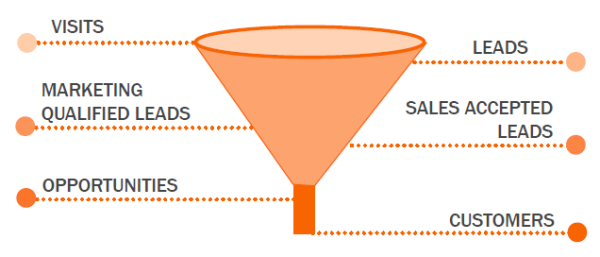Bringing Sales and Marketing Together in Your Lawn and Landscape Business
 Author: Chris Heiler
Author: Chris Heiler
 As an inbound marketing agency, our objective is simple: Build brand awareness, increase customer loyalty and generate qualified leads for our green industry clients. But we don’t stop here, because after all, our ultimate purpose is to enable our clients to close more sales and increase revenue and profits.
As an inbound marketing agency, our objective is simple: Build brand awareness, increase customer loyalty and generate qualified leads for our green industry clients. But we don’t stop here, because after all, our ultimate purpose is to enable our clients to close more sales and increase revenue and profits.
In order for us to do this, we need to bring marketing and sales closer together. In many companies, the marketing and sales teams operate in silos, unaware of what each is working on. There’s a disconnect between the two.
This disconnect can cause a lot of problems. Here are just a few:
- Your sales team wastes valuable time chasing unqualified leads
- Leads get lost or dropped and opportunities are wasted
- Return on investment (ROI) of your marketing efforts is difficult to measure because your marketing team doesn’t know what leads are turning into actual sales.
- It’s near impossible to measure cost per lead (CPL) and cost of customer acquisition (COCA)
- Seasonal promotions are difficult or ineffective because your sales team has no clue what the marketing team is up to (and vice versa).
Over the coming months we’re going to dive into how your green industry business can close this gap between marketing and sales (so subscribe to this blog if you haven’t already). We’ll start with some basics in this post and move toward more advanced strategies.
Speaking a common language
Open, candid communication between departments is difficult enough. It’s damn near impossible if you’re speaking a different language.
What’s a “prospect”? What’s a “contact”? What’s a “lead”? What makes for a “good” lead? How about a “bad” lead? Is Mrs. Jones a “client” or a “customer”?
One of the starting points in bringing your marketing and sales team closer together is to define a common language. This may sound simplistic, but creating standard language will help you avoid confusion and get your teams thinking alike.
When we begin working with a new client we try to standardize the terminology related to “Lifecycle Stage”, “Lead Source” and other language specific to the unique business (“Client Type”, “Property Type”, “Industry”, etc).
In this post we will focus on Lifecycle Stage.
Not all leads are created equal
Lifecycle stage is how you define where a contact is in your sales cycle or sales funnel.
Here is why it is so important to identify and track lifecycle stage of your contacts:
- Make reporting easier; paint a better picture that everyone on your team can understand.
- Benchmark your marketing and sales efforts against past months and years.
- Spot weaknesses in your sales funnel. Where are you lacking?
- Better measure the ROI of your marketing efforts.
- Better measure marketing and sales team member’s performance. Track goals more easily and hold team members accountable.
- Better understand which leads to focus your valuable time on.
- Communicate and interact with your contacts in a more relevant and unobtrusive way by segmenting your contacts by lifecycle stage.
We classify contacts into seven unique lifecycle stages. We do this internally and recommend the same seven to our clients. We “borrowed” this methodology (and the image below) from the brilliant marketing and sales minds at HubSpot.

Subscribers
Subscribers might be fans of your business but they haven’t necessarily raised their hands for your help…yet. These folks reside at the very top of your sales funnel.
These can be blog subscribers, email subscribers, Facebook fans and even Twitter followers and LinkedIn connections. It’s your marketing team’s job to engage these subscribers and move a number of them through the funnel to the next stage (we call this “lead nurturing”).
Leads
A lead is interested in what you offer and has “raised their hand” by filling out a web form, requesting a consultation, responding to a direct mail piece, etc. A lead may or may not be ready to buy right now. Either way, a follow up process needs to begin.
Not every lead is going to be A+ primo. Because of this we implement a lead scoring process internally and with our clients that is based on demographics, lead source and specific actions (emails opened, website views, etc). We’ll cover this scoring process in a future blog post. We avoid applying an arbitrary “good” or “bad” label to leads.
Marketing Qualified Leads (MQLs)
Some leads just aren’t a fit for your company, or they are not ready to make a buying decision. When you acquire a new lead, you really have three options: You either cut ties, continue your lead nurturing process (nudging them through your sales funnel) or push this “qualified” lead to your sales team so they can work their magic.
An MQL is a lead that is qualified to do business with you. In our case, an MQL would look like this:
- Business owner or executive of a green industry company
- Annual revenue over $2 million
- Has shown interest in our agency by downloading content from our website, visiting numerous pages (including sales-related pages), visiting our site multiple times, opening a high percentage of emails, etc. Their actions show interest.
For a B2B landscape management company a marketing qualified lead may look like this:
- Property management company overseeing multiple retail properties in your local market
- Multiple people from the company have visited your website, including your Testimonials and Newsroom pages. They also downloaded a free case study and white paper.
(We use HubSpot’s marketing-automation software to collect this data and monitor website activity.)
Sales Accepted Leads (SALs)
At this point, your marketing team has “set the hook”. They acquired and qualified the leads. Now it’s time for your sales team to bring in the big fish.
When marketing passes an MQL on to the sales team it now becomes a Sales Accepted Lead (SAL).
Opportunities
Some of these SALs will turn into opportunities for your company. A contact like this is actively engaged in your sales process and there is now a real possibility of converting this lead into a sale. Maybe they have scheduled a consultation with you or requested a proposal.
Customers
Congratulations! You landed the big fish by turning the opportunity into a paying customer.
Inactive or closed
Oh, the big fish got away? You can now consider the opportunity to be inactive or closed.
The dreaded sales meeting
Using this common language, your monthly sales meeting can sound more like this now:
Business Owner: “Marketing Team, how many leads did you generate last month? Of these, how many were Marketing Qualified Leads?”
Marketing Team: “We generated 45 new leads, of which 18 were MQLs”
Business Owner: “Sales Team, how many of the MQLs turned into Sales Accepted Leads? Have any of these turned into opportunities yet? Any customers yet?”
Sales Team: “We accepted 16 of the 18 MQLs. Of those, 10 have become opportunities so far and 2 have become customers already—a $9,000 enhancement and a $3,000/month maintenance contract.”
Business Owner: “Excellent. You’re awesome. Let’s go to lunch.”
This sure beats, “We got 30 or 40 some leads--some good, some bad. We’ve got a few proposals out there.”
I want to stress that this lifecycle classification can benefit any size company. This is not just for multi-million dollar companies with separate sales and marketing teams.
We use this internally where I alone am the sales and marketing team currently. This has been extremely valuable to us in organizing our marketing and sales efforts and understanding where all contacts are throughout the sales funnel.
Do you know where all of your contacts currently are in your sales funnel?
image credit: phocks





